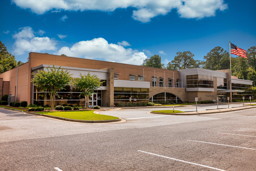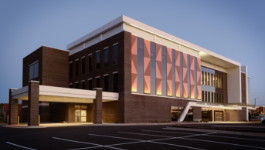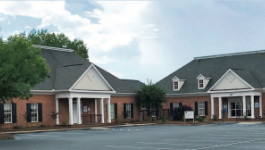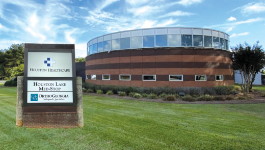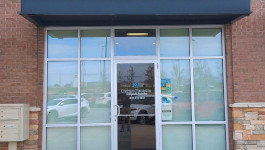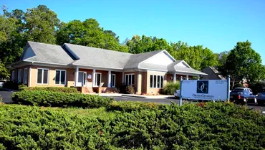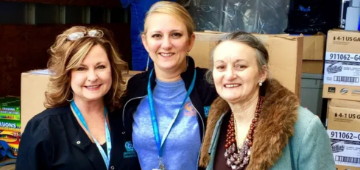Most Common Knee Injuries for Athletes – Dr. Richard Thomas
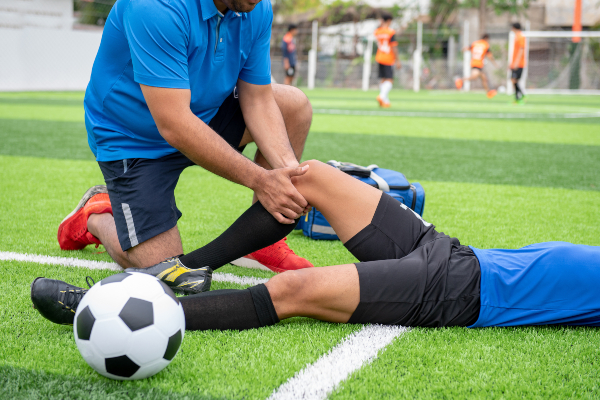
Knee injuries are one of the most common injuries seen in athletics today. Most athletes can recover completely from knee injuries and return to their pre-injury level of competition. However, some of these injuries can be career-enders and lead to chronic pain and function loss. Early detection and proper treatment of these injuries is crucial for the best possible outcome. At OrthoGeorgia, we are proud to provide comprehensive sports medicine care in Central GA, focused on the prevention, care, and rehabilitation of athletic injuries of all kinds. Keep reading to learn more from OrthoGeorgia sports medicine specialist Dr. Richard Thomas about the knee and common knee injuries athletes of all kinds may face.
Anatomy of the Knee
The knee joint is made up of 4 bones, several ligaments, and multiple muscles and tendons that are all crucial for the proper functioning of the leg. The bony anatomy of the knee is formed by the bottom end of the femur (thigh bone) articulating with the upper end of the tibia (shin bone). The upper end of the fibula (smallest bone in the lower leg) is attached to the upper end of the tibia, but does not articulate with the femur. The patella, or knee cap, slides over the front of the femur in a groove called the trochlea. All of these bones are covered with a smooth surface called hyaline cartilage that allows for minimal friction when the bones glide past each other. The meniscus cartilage is a spongy form of cartilage that acts as a cushion in between the femur and the tibia. There are two menisci cartilage for each knee.
The knee joint is restrained by multiple ligaments. Ligaments are a tough tissue that attaches bone to bone and gives the knee stability. There are four main ligaments in the knee:
- The anterior cruciate ligament (ACL)
- The posterior cruciate ligament (PCL)
- The medial collateral ligament (MCL)
- The lateral collateral ligament (LCL)
Tendons are the tough tissue that connect muscle to bone. There are multiple tendons that cross the knee joint. The most important tendons include the patellar tendon, quadriceps tendon, multiple hamstring tendons, and the iliotibial band. The knee is one of the largest and most complex joints in the body, and all parts of it work together to allow for comfortable movement both in and out of sports.
What are the Most Common Knee Injuries in Sports?
Athletes are particularly susceptible to knee injuries because of the harsh movements the knee faces during all kinds of sports. Some of the most common movements that can lead to knee damage during sports include sudden stops, twists, turns, and general pressure put on the knee joint while running. Overuse can also lead to injury. Proper diagnosis and treatment of a knee injury during sports is crucial for athletes, so they can continue to perform their best. Below are some of the most common knee injuries experienced by athletes of all kinds.
Meniscus Tear
What are the Symptoms of a Meniscus Tear?
Meniscus tears are one of the most common knee injuries in the athlete. They usually occur from a twisting injury on a planted leg. The athlete occasionally feels a pop and develops swelling over the next 24 hours. The patient may also feel a locking of the knee, where the knee gets stuck in a certain position. A sensation of clicking may also be present. The patient is rarely able to continue playing their sport after tearing their meniscus.
How is a Meniscus Tear Diagnosed and Treated?
A meniscus tear is usually definitively diagnosed with an MRI. Plain x-rays are usually normal. A physical exam will show tenderness over the joint line on the inside or outside of the knee with swelling inside the joint. There is no gross instability of the knee with an isolated meniscus tear. Occasionally the knee has definite loss of full motion secondary to a “locked” meniscus tear. Acute meniscus tears rarely heal without surgical intervention. Surgical treatment is usually arthroscopic and consists of either trimming out the torn pieces of the meniscus or repairing the meniscus with stitches.
When Can I Return to Sports After a Meniscus Tear?
Return to play after a meniscus tear depends on whether the meniscus was trimmed out or repaired. If the meniscus was trimmed, the athlete can go back to sports within 4 to 8 weeks – after full motion and strength are obtained. If the meniscus was repaired, the athlete must remain non-weight bearing for 4 weeks and may not go back to sports for 4 to 6 months.
MCL Tear
What is an MCL Tear?
Medial collateral ligament tears are extremely common in the cutting athlete. Essentially, an MCL tear is a “sprained” knee. Often the MCL tears after the knee is placed into a forced valgus position (knock-kneed position). For example, this position can occur in an interior lineman in football who has another player fall on the outside of their knee. It can also occur as a cutting or twisting injury. Often the player feels a pop and may notice some swelling, bruising, and tenderness on the inside of the knee. Rarely does the player have swelling in the joint itself. The athlete may also have a sensation of instability or of the knee giving way.
How is an MCL Tear Diagnosed?
Usually this diagnosis can be made with a physical exam alone. X-rays are usually normal. On exam, bruising and tenderness medially (inner knee) with laxity to valgus stress (forced knock-kneed exam) is diagnostic. The knee rarely has any fluid in the joint itself and usually has full range of motion.
How is an MCL Tear Treated?
Treatment of MCL tears is usually nonoperative with a brace. Physical therapy is used to get full range of motion and quadriceps strength back to normal. Athletes can usually get back to sports within 4 to 8 weeks, depending on the severity of the tear. The player can return to sports once they can run a figure of 8 at full speed and have full range of motion.
ACL Tear
What is an ACL Tear?
The dreaded ACL tear is another common knee injury in the athlete. ACL tears do not necessarily occur after a “big hit” or a dramatic event on the playing field. Often, an athlete tears the ACL in a non-contact cutting event in which the foot is planted and the knee pivots. The athlete usually hears or feels a pop, has significant swelling in the joint within an hour of the injury, and is not able to continue playing. Female athletes have a 4 to 1 increased incidence in tearing their ACL’s than male athletes.
How is an ACL Tear Diagnosed?
Diagnosis of the ACL tear can usually be made with a physical exam, but an MRI is usually ordered for confirmation as well as evaluation of other injuries in the knee, such as meniscus tears or an MCL tear. The physical exam is positive for a significant effusion (fluid in the knee joint), tenderness over the lateral (outer) aspect of the knee, and a positive Lachman exam. The Lachman exam is the gold standard for diagnosing an ACL tear. The knee is placed in 30 degrees of flexion and the tibia is pulled forward. Increased excursion of the tibia is positive for an ACL tear.
How is an ACL Tear Treated?
For the cutting athlete, treatment of ACL injuries is almost always surgical reconstruction. The ACL tear is treated with an arthroscopically-assisted procedure in which the ligament is reconstructed with the patient’s own patellar tendon, hamstrings, or cadaver tissue. Physical therapy is crucial in getting the best result after an ACL reconstruction and involves getting the range of motion back in the knee, strengthening the muscles around the knee, and teaching the knee how to protect itself from injury using functional exercises. The athlete can usually go back to cutting activities 6 to 9 months after surgery. The athlete may have to wear a brace while participating in cutting sports.
Sports Medicine Care and Treatment for Knee Injuries in Central Georgia

The amount of force the knee endures in most forms of athletics places it in danger of injury. However, in understanding the anatomy and possible injuries of the knee, successful treatments can be initiated, and the injured athlete can return to their respective sport. Dr. Thomas and our team at OrthoGeorgia are proud to work with injured athletes with the goal of returning them to the range of motion, strength, endurance, and function they had before their injury. Our physicians, trainers, and therapists collaborate to design a custom sports medicine rehabilitation program for each athlete so they can stay at the top of their game for years to come. To learn more about the sports medicine care we provide in Macon, Warner Robins, Kathleen, Milledgeville, Dublin, and Hawkinsville, or to schedule an appointment with one of our orthopaedic sports medicine specialists, please contact us today!
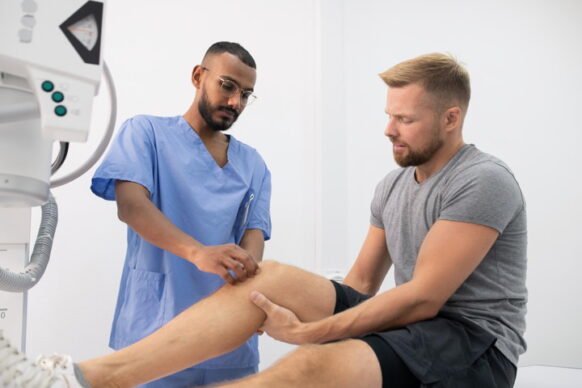
Personalized Orthopaedic Care in Central Georgia
At OrthoGeorgia, we want to help you live a healthier and more comfortable life by giving those in Macon, Warner Robins, Kathleen, Milledgeville, Dublin, Hawkinsville, and the surrounding areas convenient access to the highest quality care. Whether you have been suffering from a sports injury or a common orthopaedic condition, we will determine the cause of your discomfort and craft a personalized treatment plan to bring you relief. To learn more about our services and our physicians, or to schedule an appointment at OrthoGeorgia, please contact us today.
